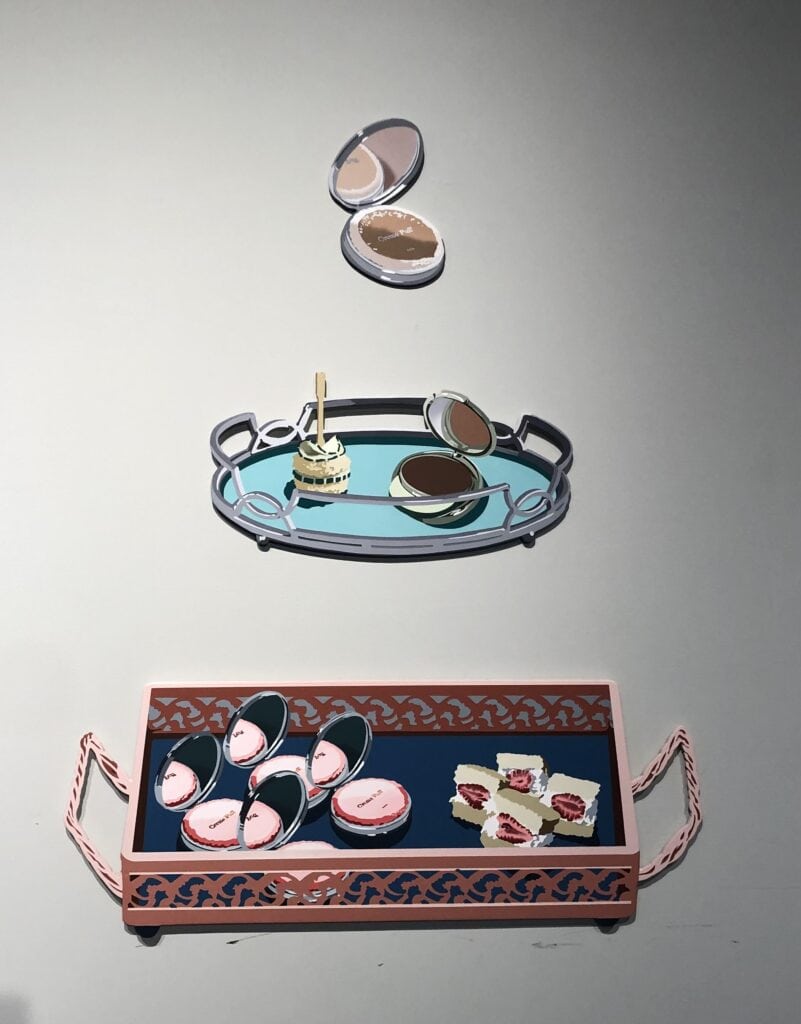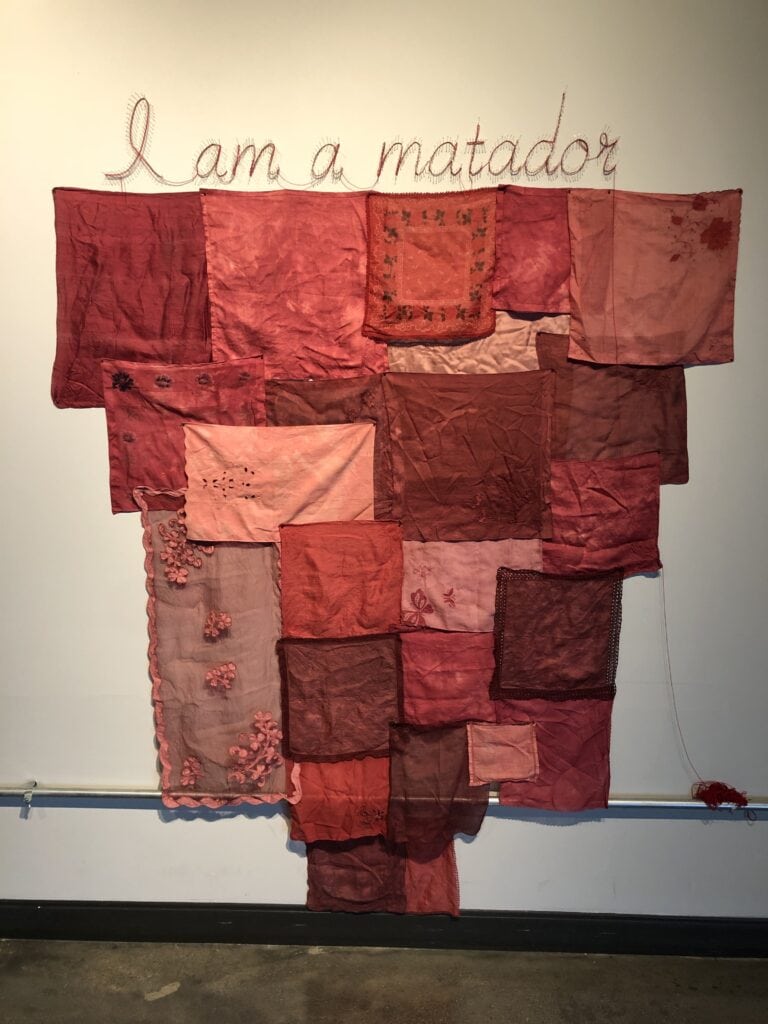The Gallery at the Summit Hotel, which brings a contemporary art focus to the trendy facility, is revisiting Cincinnati’s millennial alternative scene in the current exhibition: 20 Years Ago Today: DIT: The Collaborative Nature of Everything. In the same sense that in the world of cinema, the viewing public expands the significance of the created entertainment, an artistic pursuit of any sort is rendered nonexistent unless ‘seen’. Curated by Sue Spaid and Linda Schwartz, this exhibition hikes back to an era where break-in artists resorted to exposure opportunities in artist-run spaces as a go-to alternative art scene: doing something as opposed to doing nothing and being unseen. In the second phrase, the term DIY is morphed into DIT as in Do It Together, recognizing that there is little that we do ‘all by ourselves’ and almost everything we do is accomplished in a collaborative mode. The collaborated visual art concept involves and evolves with viewer participation, precariously dependent on both the positive and negative audience responses. Additionally, alternative spaces served as opportunities to test first run and experimental concepts that would not fly in more conventional venues.
The curators of this exhibit noted that the selected work categorized into five focus fields: art made from domestic materials, collective artworks with participant input, objects indicative of making/moving/labor, artworks inspired by everyday activities and artworld in-jokes.
In revisiting Cincinnati’s pre-millennial and millennial alternative scene, I can recall the Arts Consortium, a West End multi-purpose community center on Linn street (I was a regular sketch group participant, even during my wheelchair confinement), Semantics, a dis-established alternative located on Harrison Ave, Base Art on Main Street, Warsaw Projects, SSNova—the list goes on and on.
“The Haircut”: Everybody needs a haircut, usually a collaborative production, right? Kendall Bruns further conceptualized that everyone should have a haircut chronology, so he charted his pictorially from youth to present day. His next step was to design and mail a ballot allowing the recipient to submit their haircut specs on a frontal and side view diagram of Kendall’s head. Cutting, dyeing, shaving, all creative possibilities were encouraged. One respondent even returned his ballot as “like the guy driving a Lexus.” Kendall Bruns found that this process positioned his proposal as a therapeutic forum, fielding an outlet for a variety of public interactions, both supportive and debasing.
Frederick Ellenberger’s work falls in the category of ‘work inspired by everyday activities.’ Construction and work accomplished on the domestic scene is represented by “Mike’s Tools”. Common fabricated chipboard, fielded with rows of punctuation, is often the display organizer of choice of the homefront handyman. Ellenberger’s piece features the typical assortment of hand tools, each being an artist-fabricated object, exhibited on the black glossy surface, convincingly replicating a familiar wall mount in many man-caves of earlier eras.
Matt Lynch contributes “Progression”, modified cinder blocks, mounted on bright orange formica-clad shelving. The “concrete bits” are actually the numbers 1, 1, 2, 3, 5, 8, which signal the Fibonacci sequence, progressing from pulverized to pea-sized rubble through a variety of partial elements to a full functional form. Lynch also displays “Pangaea Kitchen Plan” 2022. His works are at first glance typical consumer building goods, gently subverted with a subtle satirical undercurrent.

Rachel Rampelman creates work that explores gender, artifice and spectacle, rendered in digital prints, possibly made with a digital camera or scans of photos. Entitled: “Megalomania Fabrication Vacation International, Inc.” (MFV Inc), this work is a solicitation in response to the social media affliction of vacation spectacularization to the heights of envy. Arranged on the wall in a pyramidal yellow format, this multitude of ultrachrome digital prints lampoons the hyper culture of the absurd with hilarious facial expressions and gestural antics that can be “manufactured on your behalf to enjoy personally for the rest of your life”, massaging the feelings of inadequacy of the vacation intimidated or uninitiated or paranoid. You get the picture.

Woman’s labor in the domestic domain is the theme of a series of pieces. Lori Larusso’s “Unpaid Labor” appears to be an acrylic abstraction but on closer inspection the painting is composed of a full sized ironing board and uprighted Iron, executed in soft neutral tonalities that deny the sustained battle against laundry wear and tear with bleaching, starching, ironing and repair and other activities that contribute to the comfort of home at the expense of unpaid labor. “Domestic Perfection” is a series of acrylic painted panel cutouts memorializing the assigned role of the perfect hostess and the responsibility of domestic entertainment which is to anticipate every comfort and concern on all occasions. Depicted as a single open compact, and as multiples on a variety of service trays in gentie turquoise and pinks. The mirror in the lid reflects the perfect pristine facial powder, poised to match various pigmentations, as the essential finishing component of the mask of beguiling cosmetic artistry.

Finally, I was intrigued by a piece by Alice Pixley Young entitled “I am a Matador.” Captured butterflies, lilting florals and a variety of elaborately embroidered initials of generations of women punctuate a collection of kerchiefs, side table fancy pieces and hand-edged headrest pieces designed to preserve the cleanliness of favored upholstered sectionals. Dyed to varying shades of crimson, faded pinks and red, Young arranged these on the wall as a delicate shield of deflection in the bull ring of domesticity. The title of the work, “I am a Matador” is written with multiple strands of red threading in perfect script, bristling overhead on a close-set line of spiky dressmaker pins above the assembled cape of woman-provided comforts.
These works resonated with me, as I remembered my grandmother’s and mother’s perfected laundry technique and their weekly mountains of ironing. I treasured for years their ‘fancy pieces’ and embroidered kerchiefs, even though the flourished initials did not match my given name or the names of my children.
Exhibition on view through Oct 28, 2023.